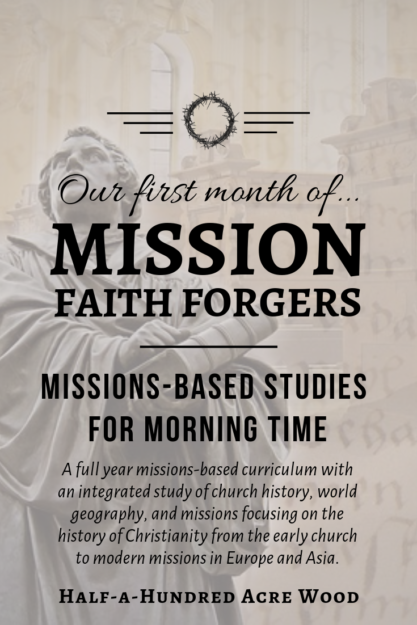
Choose joy. Learning can be hard, but it’s also exciting and rewarding. If you’re filled with a sense of dread as you enter a new school year, it’s time to change what you’re doing.
A few weeks ago, we shared some lessons learned from over a decade of homeschooling, but there’s a particular lesson learned that’s been most on my mind lately because… our homeschool has started with such peace and joy this year. A few years ago, our homeschool had become governed by panic and dread which stripped the peace and joy from our learning endeavors. As we have followed God’s leading in our lives, peace and joy have returned. I didn’t realize the bondage we were in until I handed our choices, plans, and expectations all over to God and sought His will above all else. I had to stop letting what others think play such a large role in our educational decisions.
So, here we are, five weeks into our school year. We wanted to share a glimpse of what homeschooling has looked like in our home with four boys ranging from kindergarten to eleventh grade, since some have asked for more details about what it looks like in action.
Morning Time: Mission Faith Forgers
We’re a month into our Mission: Faith Forgers curriculum, a study that incorporates church history, world geography (Europe & Asia), world history (from Reformation to modern day), astronomy, physical science, and fine arts. Our family starts together with this morning time which currently takes us around 30-45 minutes. This is our most special time, and our teenagers enjoy being involved. (They offer so much to our family discussions – such a treasure!)
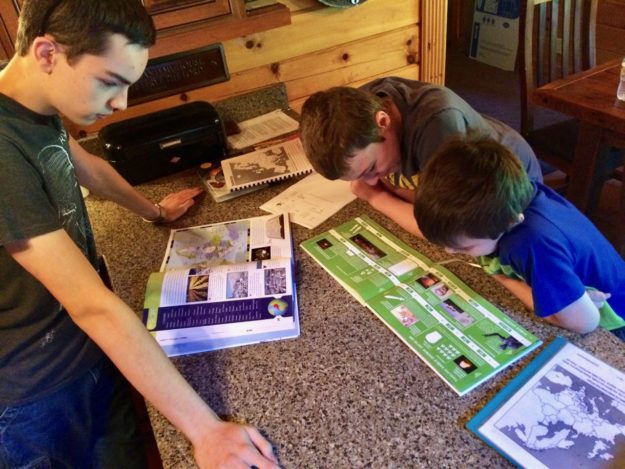
As part of our study of church history, we’ve been introduced to Christians of the early church to the Middle Ages, including…
- Paul
- Polycarp
- Blandina
- Perpetua
- Constantine
- Athanasius
- Ambrose
- Augustine of Hippo
- Patrick of Ireland
- Clovis
- Pope Gregory I
- Boniface
- Alfred the Great
- Anselm
- Bernard of Clairvaux
- and Charlemagne.
As we’ve studied these early church leaders and martyrs, we’ve discussed questions such as:
- How could Polycarp’s courage embolden other Christians to remain faithful to Christ? How could our courage embolden others in the same way?
- How could an account of martyred believers be an encouragement for others to hold fast to the faith?
- How was Constantine’s influence in the church positive? How was it negative?
- Discuss the importance of kindness as a witness to others.
- What are some reasons we would want to study the life of others (re: Augustine reading about the transformed life of St. Antony)?
- Why would someone want to dread riches in this world more than hardship?
- Should the king be a spiritual leader and rule the church? Why or why not?
- How did memorizing Psalms affect Alfred the Great’s times of trial?
- What can we do as a family to show “acts of mercy and kindness for the sick and poor” (re: Bernard’s mother, Aleth)?
We’ve also touched on major events of church history, such as…
- When the Bishop of Rome became Pope
- Creeds & Councils
- East-West Schism of the Church
- Islam and the Crusades
The art projects this semester help with giving a shared experience to remember certain aspects of church history while also giving exposure to various art mediums…
The Family Tree of Faith. A simple watercolor tree has provided a backdrop for adding the names of various people of faith through history. This is our “family tree of faith.” It’s a beautiful reminder that Paul, Polycarp, Augustine, and St Patrick are our brothers in Christ!
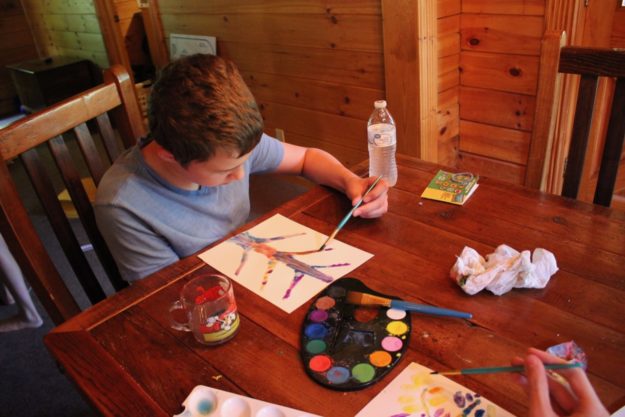
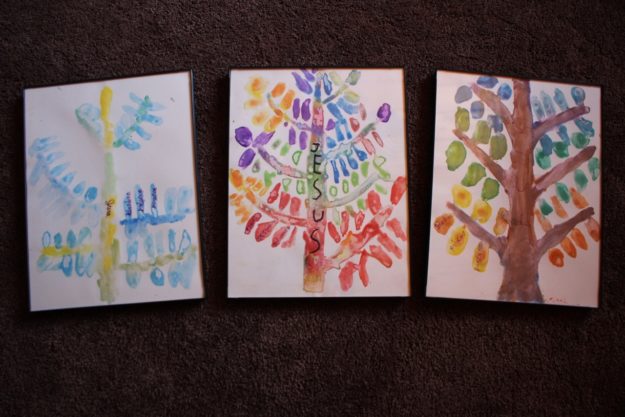
Roman/Byzantine Mosaics. Mosaics were one of the most popular forms of art during the Byzantine Empire (which was influenced by the art of the Greeks and Romans). Because the early church was established during the Roman empire, we used mosaic art to depict some of the symbols of the early church. (We made the gemstones out of glue globs.)

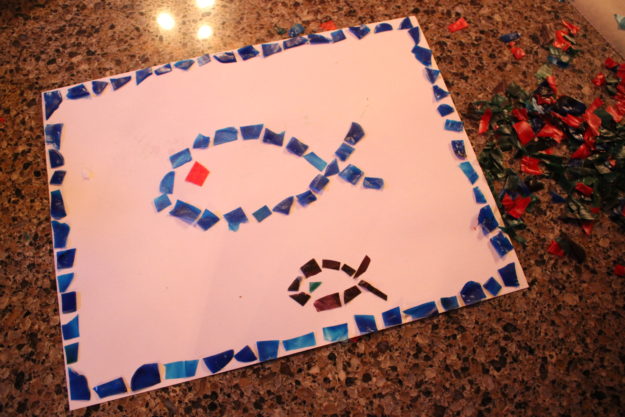
Rubber Band Prints. Using rubber bands, we experimented with printmaking, making prints of Charlemagne with his crown and the Chi Rho symbol (re: Constantine).
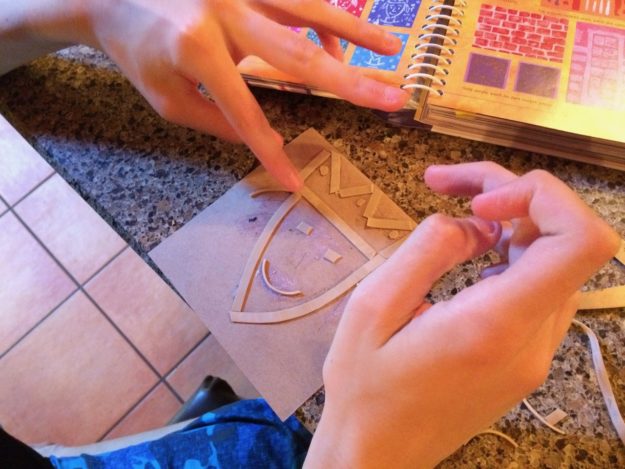
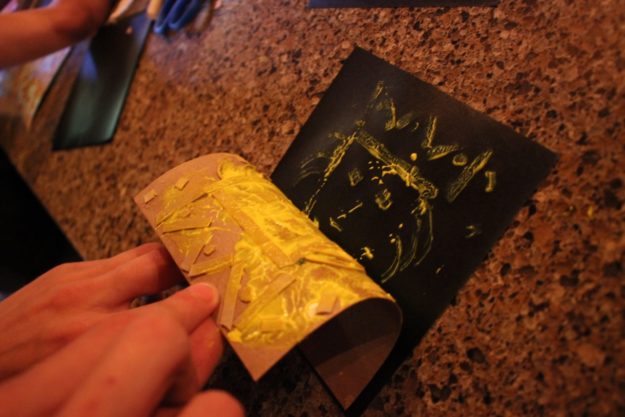
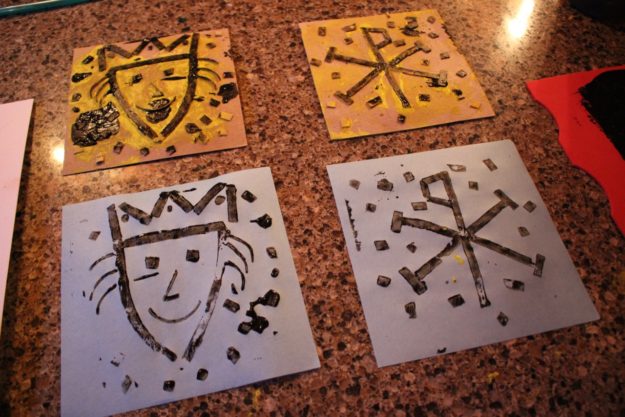
(Here’s a reminder that printmaking designs show up in reverse!)
Tree techniques. Anselm often used analogies and object lessons in explaining Scripture. One such example is when he compared boys to trees, urging teachers to train and discipline boys in love. After taking a look at some of Van Gogh’s trees, we used a variety of mediums (oil pastels, chalk pastels, watercolors) to practice different techniques.
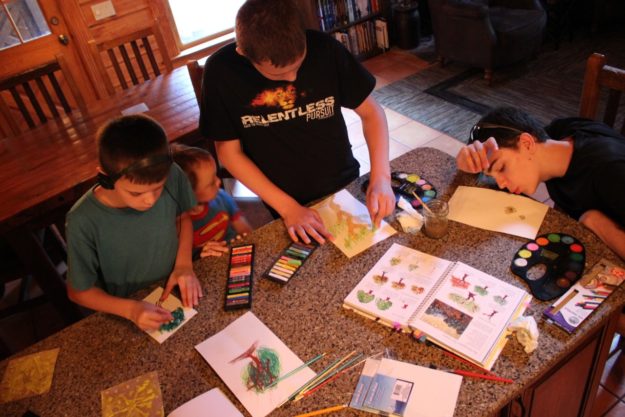
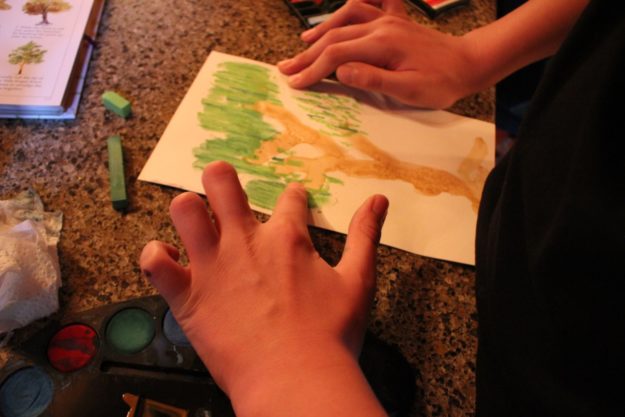
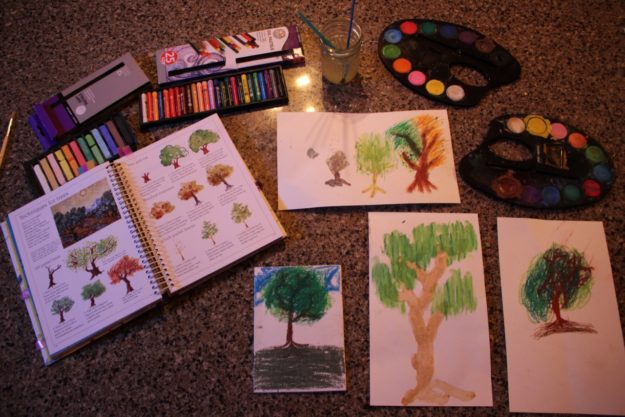
Likewise, we’ve been studying hymns that tie into our study of church history:
- Fairest Lord Jesus, a hymn emphasizing Christ’s dual nature as both human and divine (an issue that led to the writing of the Nicene Creed)
- Be Thou My Vision, an old Irish hymn of the 8th Century (which tied into our study of St Patrick of Ireland)
- All Glory, Laud, and Honor, which was written by a bishop that had been appointed as a church leader in France by Charlemagne
- Jesus, the Very Thought of Thee, written by Bernard of Clairvaux, a monk who became involved in the Second Crusade
To round out fine arts, we’ve reviewed composers from last year’s study of Mission: World Wonders (Vivaldi, Bach, Haydn, Mozart, and Beethoven) and are currently learning about the stringed instruments and music featuring the strings section.
Scripture memorization and geography are also important parts of Mission: Faith Forgers. Thus far, we’ve memorized…
- Genesis 1:1-5
- Books of the Bible
- 26 different countries in Southern and Western Europe

For science, we’ve been working through a study of astronomy, learning about Copernicus, the Earth’s movement, Foucault’s Pendulum, telescopes, Galileo, constellations, asterisms, stars, nebulae, quasars, astronomy vs. astrology, asteroids, comets, and meteors.
Mission: Faith Forgers has taken us less than 30 minutes every day except for those days when we incorporate an art project. Just a little bit each day has taken us a long way! (If you’re interested in what our reading guide/plan looks like, download this sample.)
A Glimpse of Other Subjects, Middle School, & High School
Latin. I’ve mentioned this before, but let me just say it again. We love Visual Latin. During the Latin Bible readings, our 10-year-old sometimes accidentally translates sentences instead of repeating them aloud in Latin. He’s already starting to think in Latin, and he’s truly enjoying it! (Same goes for our two teenagers.)
Middle & High School Science. It’s taken some time to help our 13-year-old understand our expectations regarding lab write-ups, but Exploring Creation with General Science 2nd Edition has been fantastic! It starts out with a history of science and then proceeds with an introduction to the scientific method and how to analyze experiments, following these foundational concepts up with studies and experiments in origins, earth science, applied science (energy & motion), and life science. The cover of this book looks dull, and the layout of the text does not include a large number of illustrations, but we’re impressed with the content! The experiments are fascinating and, although not visually appealing overall, the layout provides an opportunity to become familiar with high school level science textbooks. And… most of the experiments use common household items!
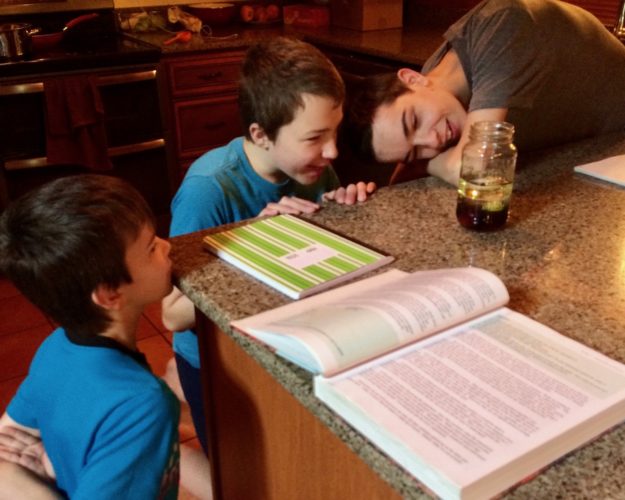
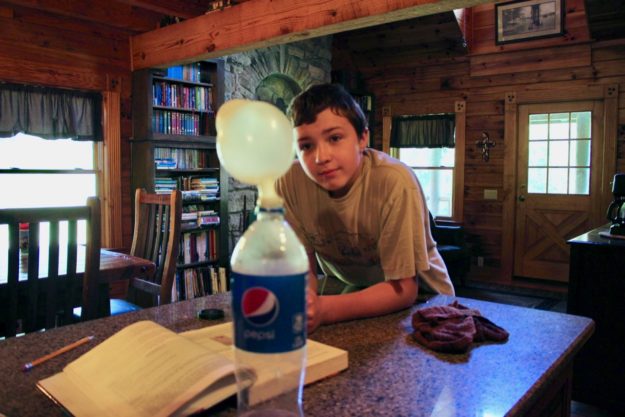
Likewise, our oldest son is enjoying Exploring Creation with Biology. He’s currently mastering the art of growing bacteria and other itty bitty lifeforms. Today, he found a paramecium among many other miniature smelly things he grew from pond scum. He’s completely in awe over microscopic life. I’m completely in awe of how much it stinks. (This is the microscope we purchased as a Christmas gift for our boys a few years ago.)
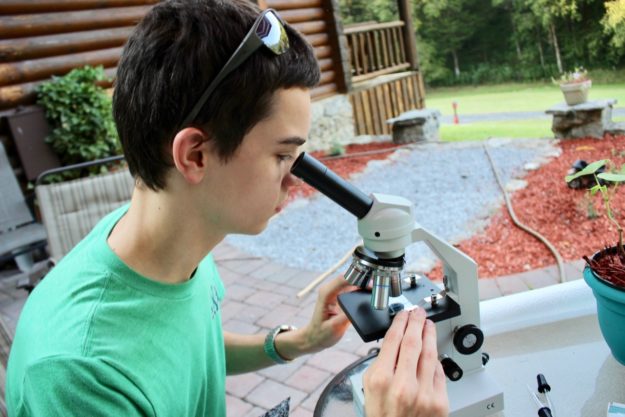
History. Last year, our history-loving high schooler used a robust high school world history curriculum but discovered that he already knew the majority of the material. (I think we owe this to our previous elementary studies from Story of the World and Homeschool in the Woods.) This year, we opted for Dave Raymond’s American History, and WOW! This curriculum has proven itself to be a step (or leap) beyond anything else we have come across for middle or high school history. Every day he discovers something new. We have much more to share about this, so it’s going to end up with a separate post, but here’s a glimpse into his work building a history portfolio.
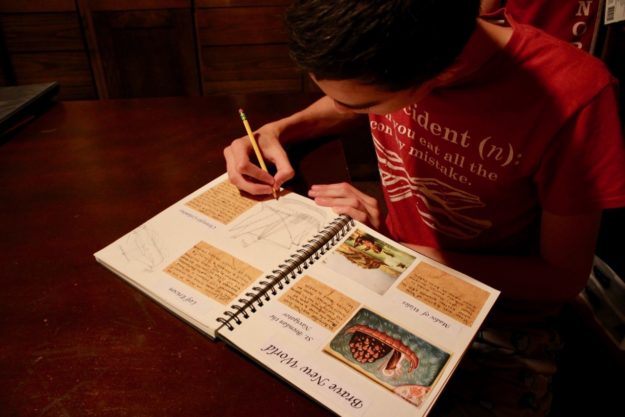
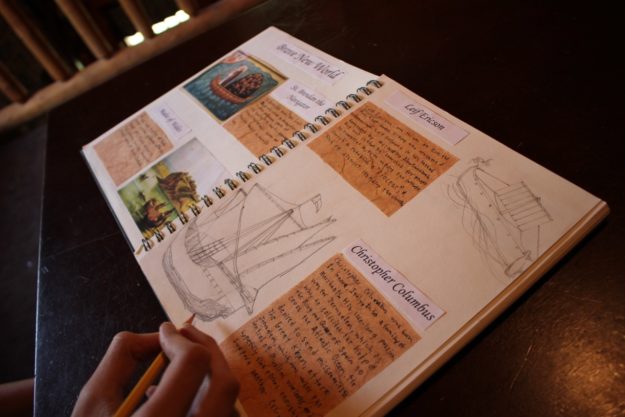
Language Arts. There’s nothing like experiencing a few weeks of our plans that reveals how our curriculum choices actually turn out in the context of reality. Every year, we usually end up making a few adjustments to better fit our needs, and this year, language arts was the adjustment.
Last year as a 4th grader, Levi worked through IEW’s Ancient History-Based Writing Lessons, which is actually designed for students up to 8th grade. Over the course of the year, his enthusiasm for writing waned considerably, which I believe mostly resulted from tackling too much too quickly. We were aiming to use IEW Modern World History-Based Writing Lessons this year, but after seeing it play out for a couple of weeks, we decided to switch to Fables, Myths, and Fairy Tales because it introduces the same structures & styles but is more appropriate for children in Grades 3-5. We recognized the value in choosing a simpler version for him so he could learn the process better. It’s going very well now. Sometimes less is more. Another lesson learned: Meet your child where he actually is, not where you think he should be.
While our 13-year-old was enjoying Cover Story, he decided he needed to challenge himself once again with the structures and styles of IEW. (This is after a year of practicing persuasive writing with Lost Tools of Writing.) He’s now working in IEW Modern World History-Based Writing Lessons which ties in well with our Mission: Faith Forgers studies. He’s also reviewing some grammar concepts using Grammar for Writers, a video course taught by the author of one of his favorite book series, the Wilderking Trilogy.
As far as other curriculum choices (i.e., spelling, grammar, reading & writing for our 5-year-old, and our oldest son’s other curriculum choices), the rest of our plan is holding steady. It has truly been a great opening to our school year. We hope you are experiencing the same peace and joy in learning that we have experienced this year!
